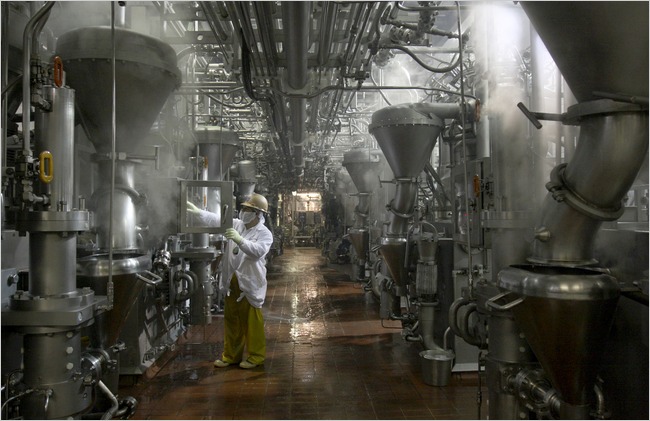McDonalds, public school lunch beef treated with ammonia
Eight years ago, federal officials were struggling to remove potentially deadly E. coli from hamburgers when an entrepreneurial company from South Dakota came up with a novel idea: injecting beef with ammonia.
The company, Beef Products Inc., had been looking to expand into the hamburger business with a product made from beef that included fatty trimmings the industry once relegated to pet food and cooking oil. The trimmings were particularly susceptible to contamination, but a study commissioned by the company showed that the ammonia process would kill E. coli as well as salmonella.
Officials at the United States Department of Agriculture endorsed the company’s ammonia treatment, and have said it destroys E. coli “to an undetectable level.” They decided it was so effective that in 2007, when the department began routine testing of meat used in hamburger sold to the general public, they exempted Beef Products.
With the U.S.D.A.’s stamp of approval, the company’s processed beef has become a mainstay in America’s hamburgers. McDonald’s, Burger King and other fast-food giants use it as a component in ground beef, as do grocery chains. The federal school lunch program used an estimated 5.5 million pounds of the processed beef last year alone.
But government and industry records obtained by The New York Times show that in testing for the school lunch program, E. coli and salmonella pathogens have been found dozens of times in Beef Products meat, challenging claims by the company and the U.S.D.A. about the effectiveness of the treatment. Since 2005, E. coli has been found 3 times and salmonella 48 times, including back-to-back incidents in August in which two 27,000-pound batches were found to be contaminated. The meat was caught before reaching lunch-rooms trays.
…
Carl S. Custer, a former U.S.D.A. microbiologist, said he and other scientists were concerned that the department had approved the treated beef for sale without obtaining independent validation of the potential safety risk. Another department microbiologist, Gerald Zirnstein, called the processed beef “pink slime” in a 2002 e-mail message to colleagues and said, “I do not consider the stuff to be ground beef, and I consider allowing it in ground beef to be a form of fraudulent labeling.”
One of the toughest hurdles for Beef Products was the Agricultural Marketing Service, the U.S.D.A. division that buys food for school lunches. Officials cited complaints about the odor, and wrote in a 2002 memorandum that they had “to determine if the addition of ammonia to the product is in the best interest to A.M.S. from a quality standpoint.”
“It is our contention,” the memo added, “that product should be labeled accordingly.”
Represented by Dennis R. Johnson, a top lawyer and lobbyist for the meat industry, Beef Products prevailed on the question of whether ammonia should be listed as an ingredient, arguing that the government had just decided against requiring another company to list a chemical used in treating poultry.
School lunch officials said they ultimately agreed to use the treated meat because it shaved about 3 cents off the cost of making a pound of ground beef.
119 Responses to “McDonalds, public school lunch beef treated with ammonia”
-
Judy Knudsen January 24th, 2011 at 11:36 AM
A starving, stray cat at my home would not eat the remainder of my McDonald’s hamburger. This tells me it’s not good for me either.
-
@Judy My dog wont eat fresh lobster. But he will eat his own dog poop. I wouldn’t consider it wise to take eating advice from an animal.
-
is having fast food restaraunts connected with school lunches healthier then the original foods served?
-
Definitely not.
Leave a Reply
You must be logged in to post a comment.





 NoScript extension
NoScript extension
